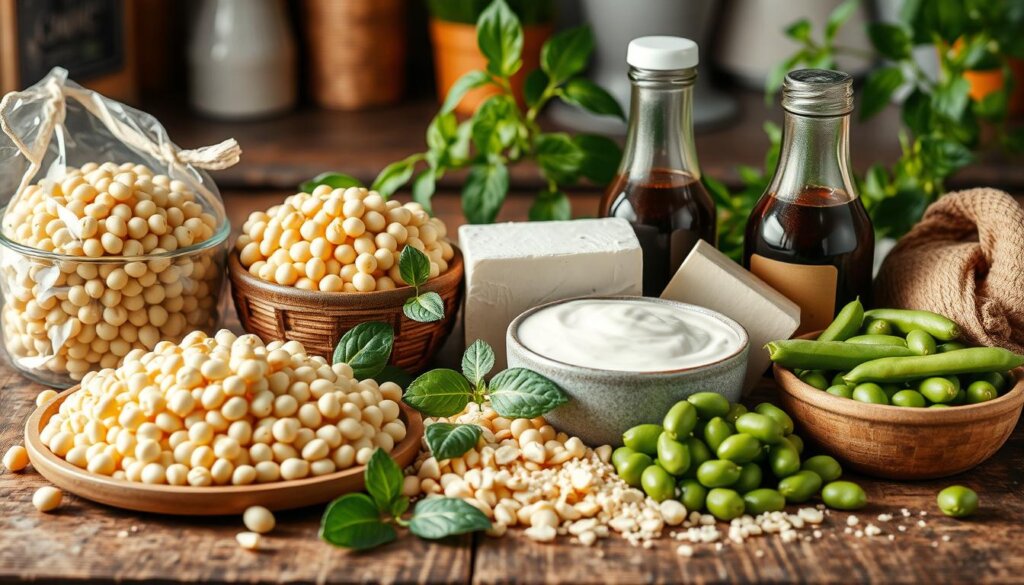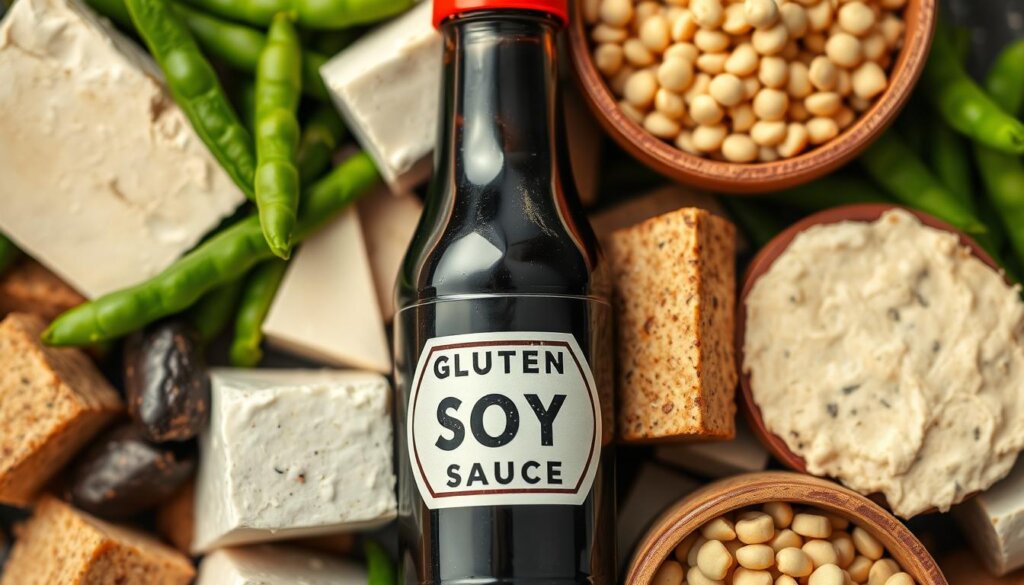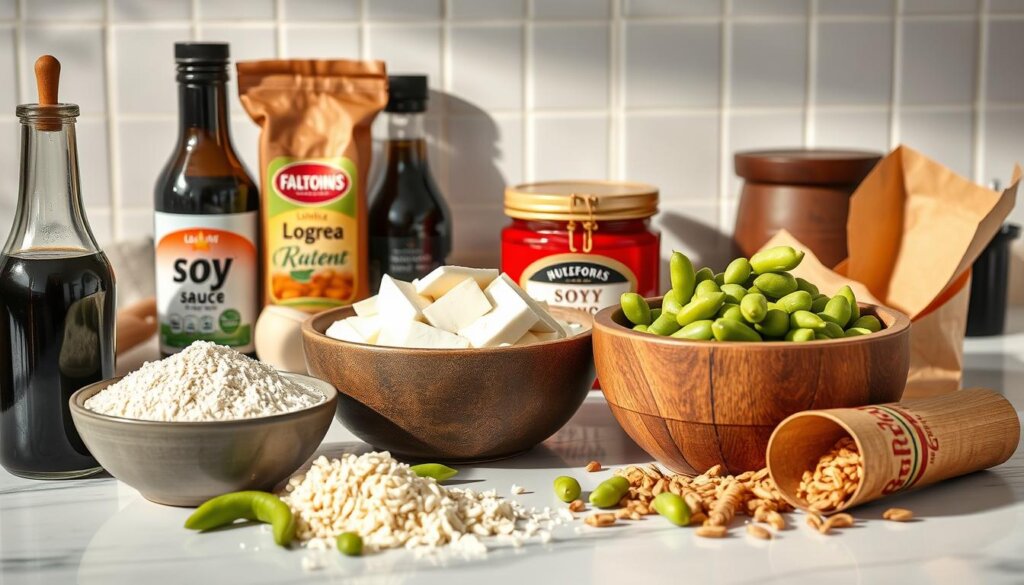Ever wondered if soy fits into your gluten-free diet? With gluten intolerance and celiac disease affecting 1 in 100 people worldwide, it’s vital to understand which soy products are safe. While soybeans are naturally gluten-free, some soy products risk cross-contamination during processing.
Discover gluten-free options like Gluten-Free Soy Sauce Alternatives and explore Chickpea Flour as a Gluten-Free Substitute for cooking. For snacking ideas, check out Safe Snacks for Gluten Intolerance. Knowing your soy products ensures you stay healthy while enjoying your gluten-free diet.
Table of contents
Understanding Gluten and Its Importance
Knowing about gluten is key for those with dietary limits. Gluten is a protein found in grains like wheat, barley, rye, and triticale. Most people don’t notice it. But, those with gluten intolerance or celiac disease react badly to even small amounts.
What is Gluten?
Gluten makes dough elastic and helps bread rise. It’s what makes bread chewy. But, for those with gluten issues, it’s a big no-no. About 1 in 133 Americans must stick to a gluten-free diet.
The Role of Gluten in Food
Gluten isn’t just for bread. It adds texture to many foods. But, gluten-free options can be tricky. They might be high in calories and sugar. Knowing what gluten is helps you pick better choices.
Is Soy Naturally Gluten-Free?
Do you wonder if soy products are safe for those with gluten issues? The good news is that soybeans and soy proteins are naturally gluten-free. This makes them a great choice for those with gluten sensitivity or celiac disease.
The Composition of Soybeans
Soybeans don’t have gluten proteins like wheat, barley, and rye. This is good news for those avoiding gluten. Soybeans are full of protein and are key for vegetarians and vegans. They’re also packed with nutrients, making them a favorite protein source.
The Safety of Soy Protein
When it comes to soy protein safety, unprocessed soy is safe from gluten risks. Foods like tofu, edamame, and tempeh are good choices. But, it’s important to watch out for processed soy products that might have gluten. Knowing this helps you make better food choices.

| Aspect | Details |
|---|---|
| Natural Gluten-Free Status | Yes, soybeans and pure soy products are gluten-free. |
| Composition of Soybeans | Contains protein, healthy fats, vitamins, and minerals. |
| Common Soy Products | Tofu, edamame, tempeh, and soy milk. |
| Processed Soy Risks | Some may contain gluten due to additives. |
| Recommended for | Individuals with gluten sensitivity or celiac disease. |
Is Soy Products Gluten Free?
It’s important to know if soy products have gluten for those on a gluten-free diet. Pure soy like tofu and soy milk are usually okay. But, processed soy can have different amounts of gluten. Knowing this helps you choose better.
Pure Soy Products
Pure soy items like tofu, soy milk, and soybean oil don’t have gluten. They’re made from whole soybeans and are safe unless they get contaminated. Many brands make sure their soy products are gluten-free. For example, Silk and Pacific Natural Brands offer gluten-free soy milk.
Processed Soy Products
Processed soy can be tricky because of gluten. Unlike pure soy, these might have additives or be made where gluten is present. For example, regular soy sauce has wheat, so it’s not good for those avoiding gluten. But, there are gluten-free soy sauce alternatives like tamari and coconut aminos. They’re tasty and safe. Always choose products labeled as gluten-free to be sure they’re safe.
| Product | Gluten Content | Notes |
|---|---|---|
| Pure Soy Milk (Silk) | Gluten-free | Safe for gluten sensitivities |
| Tofu | Gluten-free | Check for cross-contamination |
| Conventional Soy Sauce | Contains gluten | Made with wheat |
| Tamari Soy Sauce | Generally low gluten | Better option for gluten sensitivity |
| Coconut Aminos | Gluten-free | Healthy alternative to soy sauce |
| Bob’s Red Mill Soy Flour | Gluten-free | Perfect for baking |
Common Soy Products and Their Gluten Content
Understanding soy products is key for a gluten-free diet. Different soy foods have different gluten levels, depending on how they’re made. Knowing which ones are safe is important.
Soy Sauce: The Gluten Dilemma
Soy sauce can be tricky for those on a gluten-free diet. Many brands, like Kikkoman, use wheat, making them high in gluten. But, there are gluten-free options like tamari.
Brands like Kikkoman also offer gluten-free soy sauce. This means you can enjoy soy flavors without gluten risks.
Other Soy Products to Consider
There are many soy products to look at. Natural soybeans are gluten-free and full of protein. Soy milk and soy flour have different gluten levels.
You can find gluten-free soy milk and flour easily. Nutrioli’s soy oil is also gluten-free, so you don’t have to worry about additives.

Identifying Gluten-Free Soy Options
Exploring soy products means finding gluten-free ones for a healthy diet. Many soy products, like soy sauce, can have gluten. But, there are gluten-free soy sauce alternatives. This way, you can enjoy flavors without gluten.
Gluten-Free Soy Sauce Alternatives
Many brands offer gluten-free soy sauce. Here are some popular ones:
- San-J’s gluten-free soy sauce, made with special ingredients.
- La Choy’s gluten-free soy sauce, tastes similar but is gluten-free.
- Many tamari sauces are naturally gluten-free.
These options give you the taste you want without gluten risks.
Label Reading for Gluten-Free Assurance
It’s important to know how to read labels for gluten-free soy products. Here’s what to look for:
- Check for the gluten-free soy sauce label, showing it meets FDA standards (
- Watch out for maltodextrin, which might have gluten.
- If wheat is listed, the product likely has gluten.
- Look for certifications from groups like the Gluten Intolerance Group. They ensure products have low gluten levels.
By using these tips, you can pick products that fit your dietary needs.
Cross-Contamination Risks with Soy Products
It’s important to know about cross-contamination risks with soy products. This is key for people with gluten sensitivities or celiac disease. Cross-contamination happens when gluten from other foods gets into gluten-free products. This makes gluten-free foods a risk for gluten exposure.
This risk is higher in places that make both gluten-containing and gluten-free products.
What is Cross-Contamination?
Cross-contamination is when gluten gets into foods that should be gluten-free. This often happens in places that make soy products like soy sauce and tofu. These places also make gluten-rich foods.
A study in the United States found that 10% of foods labeled as gluten-free had more than 20 mg/kg of gluten. This shows the danger of hidden gluten. Also, 19% of foods that weren’t labeled as gluten-free had more than 20 mg/kg of gluten.
Preventing Cross-Contamination
When buying and eating soy products, preventing cross-contamination is key. Here are important steps to take:
- Choose certified gluten-free products whenever possible.
- Read labels carefully for gluten-free assurance.
- Be wary of items like soy flour and soy milk, if they’re processed in shared facilities.
- Inform restaurant staff about your gluten-free needs when dining out.
- Consider carrying epinephrine if you have severe allergies and ensure medical alert jewelry is worn.
Knowing the risks of gluten-free soy products helps you make safer choices. With the right steps, you can avoid cross-contamination dangers.

| Study Location | Percentage of Gluten Contamination | Product Type |
|---|---|---|
| United States | 10% | Gluten-free labeled foods |
| United States | 19% | Non-labeled naturally gluten-free foods |
| United States | 21% | Certified gluten-free foods |
| Canada | 9.5% | Naturally gluten-free ingredients |
| Brasilia | 22% | Gluten-free products from bakeries |
Health Considerations for Soy Consumption
Understanding soy’s impact on diets is key. People with celiac disease often ask if soy is safe. Pure soy is gluten-free and safe for most.
Is Soy Safe for People with Celiac Disease?
Studies show soy is okay for those with celiac. But, watch out for gluten in processing. Always check labels for gluten-free.
Soy can be a good protein source. It’s as good as animal proteins.
Understanding Soy Allergies vs. Gluten Intolerance
Soy is safe for gluten issues, but soy allergies are different. They can cause many symptoms. Knowing the difference is key.
For more on gluten intolerance, check this: Gluten Intolerance Management.
| Condition | Impact of Soy |
|---|---|
| Celiac Disease | Safe with pure soy products; watch for cross-contamination. |
| Gluten Intolerance | Generally safe; individual tolerance may vary. |
| Soy Allergies | Potentially harmful; requires avoidance of soy products. |
Knowing about soy can help you eat better. It’s important to be careful. This way, you can enjoy your food without health worries.
Conclusion
Adding gluten-free soy products to your diet can be very beneficial. But, it’s key to know what you’re choosing. Pure soybean oil is naturally gluten-free. It’s great for cooking because it has a high smoke point and tastes neutral.
But, watch out for cross-contamination, which can happen with less refined soy. Always pick certified gluten-free soybean oils. This way, you can be sure you’re making safe choices.
Knowing about gluten is very important, like for people with celiac disease or gluten sensitivity. Soy protein is a good substitute, but always check the labels. This helps you make sure you’re getting the good stuff without harming your health.
For more help on gluten-free, casein-free, and soy-free diets, check out these resources.
By doing your homework and making smart choices, you can add soy to your diet safely. This process is about learning about soy and how it fits into a healthy lifestyle. Keep looking for new info and adjust your cooking habits for a better diet.
FAQ
Is soy gluten-free?
Yes, soybeans and soy proteins are naturally gluten-free. They don’t have gluten, making them safe for those with gluten sensitivity.
What soy products should I avoid if I’m gluten-sensitive?
Avoid traditional soy sauce because it often has wheat. Always check labels for processed soy products. They might have additives or be made in facilities with gluten.
Are there gluten-free alternatives to soy sauce?
Yes, there are gluten-free soy sauce options like tamari, San-J, and La Choy. Always check the ingredient labels to make sure they are gluten-free.
How can I prevent cross-contamination when consuming soy products?
Choose certified gluten-free soy products to avoid cross-contamination. Be careful with soy flour or soy milk, as they might be made in facilities that handle gluten.
Can individuals with celiac disease safely consume soy?
Pure soy products are safe for those with celiac disease. But, it’s important to avoid processed products that might have gluten or cross-contaminants.
How do I identify gluten-free soy options while shopping?
Look for labels that say “gluten-free.” Get to know gluten-free soy brands and their ingredients. This helps you make safe choices.
Are there any health concerns related to soy consumption?
Soy is generally safe for most with celiac disease. But, some might have soy allergies. It’s key to know the difference between gluten-related issues and soy allergies to avoid problems.
What soy products are not gluten-free?
Soy products like traditional soy sauce, some soy-based marinades, and processed soy foods (e.g., meat substitutes or flavored tofu) may contain gluten due to wheat additives or cross-contamination.
Why do celiacs react to soy?
Celiacs don’t react to soy itself but may react if soy products are contaminated with gluten or if wheat is used as an ingredient.
Can you eat soy if you’re gluten-free?
Yes, you can eat soy if you’re gluten-free, provided the product is free from gluten contamination and additives. Look for certified gluten-free labels.
Why is soy sauce not gluten-free?
Traditional soy sauce is not gluten-free because it is brewed with wheat. Gluten-free alternatives like tamari use only soybeans in the fermentation process.





